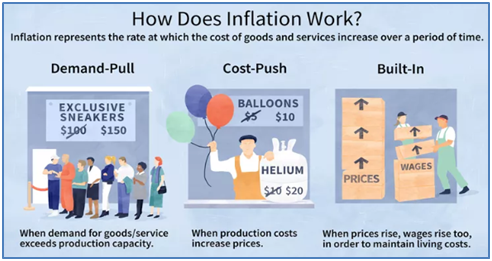Why in News?
- According to the latest National Statistical Office (NSO) data, India’s retail inflation rate eased to 6.83% in August from a 15-month high of 7.44% in July 2023, mainly due to a slide in prices of food items, especially vegetables.
- However, it continued to remain above the upper limit of the 4+/-2% band of Reserve Bank of India’s (RBI) medium-term inflation target.
What’s in Today’s Article?
- Understanding Inflation
- Highlights of the Recent NSO Data
- Key Takeaways from the Recent NSO Data
Understanding Inflation:
- Meaning:
- Inflation is a rise in prices, which can be translated as the decline of purchasing power over time.
- The rate at which purchasing power drops can be reflected in the average price increase of a basket of selected goods and services over some period of time.
- The rise in prices, which is often expressed as a percentage, means that a unit of currency effectively buys less than it did in prior periods.
- Inflation can be contrasted with deflation, which occurs when prices decline and purchasing power increases.
- Causes:
- Types:
- The Consumer Price Index (CPI): The CPI is a measure that examines the weighted average of prices of a basket of goods and services at the consumer/retail level.
- The Wholesale Price Index (WPI): It measures and tracks the changes in the price of goods in the stages before the retail level.
- Inflation targeting in India:
- The RBI Act 1934 provides a statutory and institutional framework for ensuring price stability while maintaining the objective of growth.
- The RBI Act was amended by the Finance Act 2016 to constitute a Monetary Policy Committee (MPC).
- The MPC will release the bimonthly Monetary Policy Report, for fixing the benchmark interest rate in India, bringing more transparency and accountability in fixing India's Monetary Policy.
- The current mandate of the MPC is to maintain 4% (+/-2%) annual inflation rate (CPI) and the committee is answerable to the Government of India if the inflation exceeds the range prescribed for three consecutive quarters.
Highlights of the Recent NSO Data:
- The retail inflation of 6.83% in August 2023 makes it the 4th instance of headline inflation staying higher than the upper limit of the target during this calendar year and the seventh such instance since August 2022.
- High inflation is being seen as a concern by policymakers.
- In its monetary policy review last month, the RBI had kept the key repo rate unchanged at 6.50% but had hiked the inflation projection from 5.1 to 5.4% for FY2024.
- In the Index of Industrial Production (IIP), manufacturing in absolute terms improved to 141.2 in July from 135 a year ago and 141.1 in the previous month.
- The worrisome area is the contraction of 2.7% yoy in consumer durables in July 2023 and reflective of the weakness and skewness in consumption demand.
Key Takeaways from the Recent NSO Data:
- Consumer sentiments drop:
- The consumer sentiment fell by 1.5% in August 2023, after rising every month since January 2023.
- This drop in sentiments can have a real impact on the economy and Indian businesses who are gearing up for making the best sales of the year in the forthcoming festive season.
- That’s because one of the key constituents of consumer sentiment index - the consumers’ intention to buy consumer durables (cars, TVs, etc.) – is witnessing a drop.
- It is not just the stagnation in perceived incomes that may be dragging sentiments, there’s also been a rise in pessimism regarding future incomes.
- Inflation expected to stay high:
- As per the RBI projection, inflation is expected to remain above 5% till the first quarter of 2024-25 and is likely to hit the 6.2% level in the ongoing quarter (July-September) - outside the RBI’s comfort zone.
- While overall food inflation has moderated, the worrying aspect is the upward momentum in the food items like cereals, pulses and milk.
- There is risk of further upward pressure on food inflation given the skewed rainfall and low reservoir levels. The recent spike in global crude oil prices is also concerning.
- However, a comforting factor is that the continued deflation in the WPI will have a lagged impact on CPI inflation going forward.
- Also, the Central government announced a cut in cooking gas price by Rs 200/cylinder, which will benefit all the domestic LPG consumers and the beneficiaries under the Pradhan Mantri Ujjwala Yojana (PMUY).
- India’s GDP growth outlook:
- India’s potential GDP growth rate has steadily come down from around 8% just before the Global Financial Crisis of 2008-09 to just 6% before the Covid pandemic.
- The potential GDP growth rate of an economy is the rate at which its GDP can grow without causing high inflation.
- The bump in India’s GDP growth rates immediately after the pandemic hit year of 2020-21 is mainly because of a lower base.
- India’s GDP growth is facing all kinds of headwinds such as a slowing global economy, high oil prices and climate change to name a few.
- Economists estimate that the Indian economy cannot grow more than 5% over the coming decade in a business-as-usual scenario.
- While a growth rate of 4% to 5% will still be attractive from a global perspective, it is not sufficient from the domestic perspective where millions of young Indians need jobs.










